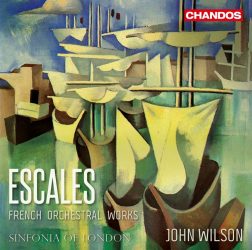Classical CD Reviews: “Escales,” “Jeux de Miroirs,” and Liszt Symphonic Works
By Jonathan Blumhofer
John Wilson and the Sinfonia of London are one of the new decade’s most exciting partnerships; Javier Perianes’s album with the Orchestre de Paris is quite clever; is Liszt’s music trash? The debate continues.

John Wilson and the Sinfonia of London are on a roll: last year’s Korngold album fired on just about all cylinders. This year’s Escales, a survey of 19th- and 20th-century French orchestral fare, does much the same.
Indeed, you know you’re in good hands from the opening track: Wilson’s snappy, brilliant account of Chabrier’s España lacks nothing for force of personality or sense of character – and it’s wonderful to hear the piece played with the commanding exuberance the Sinfonia brings to it. Ditto for their take on Saint-Saëns’s La Rouet d’Omphale.
For music of a contrasting mood and style, there’s a dreamy, sensuous performance of Debussy’s Prelude to the Afternoon of a Faun on offer, its textures lush and woodwind solos exquisitely shaped. And the famous “Méditation” from Jules Massenet’s Thaïs sings sweetly.
The disc’s three biggest numbers are Maurice Durufle’s 3 Danses, Ravel’s Rapsodie espagnole, and the title track (by Jacques Ibert).
The latter, which evokes five cities Ibert and his wife visited on a roundabout trip to Rome (in addition to the Eternal City, Palermo, Tunis, Nefta, and Valencia are sketched), gets a hearty reading: the concluding “Valencia” is particularly muscular and vital. But its subtle touches don’t get lost in Wilson’s well-paced approach to the piece. The first movement’s rich textures are carefully balanced and the oboe solos in “Tunis-Nefta” swoon.
Durufle’s 1932 score, one of only two orchestral pieces he wrote, is a lovely discovery. The first of its three movements is a frolicsome “Divertissement.” A lilting “Danse lente” follows before a driving “Tambourin” provides a cathartic outlet. Wilson and the Sinfonia bring plenty of verve and spirit to its outer movements, while the melancholy central one shimmers.
In the Ravel, Wilson and his forces take great care with the “Prélude à la nuit’s” dynamic architecture and rhythmic profile: theirs is a reading that dances with impellent mystery. Meanwhile, the “Malagueña” is rhythmically tight and the “Habanera” enticingly elegant.
For the concluding “Feria,” the Sinfonia combines flawless technical execution – rhythmic clarity, tight textural balances – and expressive vigor (the music’s gestural figures, like the mid-movement string glissandos, speak subtly). It’s a rousing conclusion to an excellent CD that, in addition to boasting first-rate engineering, cements Wilson and the Sinfonia as one of the new decade’s most exciting partnerships.
 Conceptually, Jeux de Miroirs, Javier Perianes’s new album with the Orchestre de Paris, is quite clever: it pairs two piano pieces by Maurice Ravel with his own orchestrations of them and has the G-major Piano Concerto serve as a kind of linchpin between the sets.
Conceptually, Jeux de Miroirs, Javier Perianes’s new album with the Orchestre de Paris, is quite clever: it pairs two piano pieces by Maurice Ravel with his own orchestrations of them and has the G-major Piano Concerto serve as a kind of linchpin between the sets.
The keyboard works in question are “Alborada del gracioso” (from Miroirs) and Le tombeau de Couperin, and, in this setting, one is quickly struck by the variety of Ravel’s instrumental writing in each adaptation – as well as the expressive immediacy of the original (piano) versions of both scores.
In Le tombeau, that impression is reinforced by the fact that two of its six movements weren’t orchestrated: one a touchingly sinuous fugue, the other a rambunctious, concluding “Toccata.” Those added eight minutes of music serve to enhance the suite’s expressive impact. In the original incarnation, Le tombeau is more clearly elegiac and reflective.
While Perianes’s performance of Le tombeau is less directed than, say, John Browning’s nimbly focused account, it ably captures the music’s resigned air. In particular, the “Fugue” and “Forlane” amble beautifully.
Crisp rhythms and excellent balances are ever-present in Perianes’s Le tombeau, as they also are in his lively reading of “Alborada” that closes the album.
Ravel’s orchestration of that piece, of course, packs a Technicolor punch, one that Josep Pons draws out capably – if not quite spectacularly (look to Ernest Ansermet or Jean Martinon for that) – from the Orchestre de Paris on the disc’s first track. The pairing’s approach to the chamber-orchestra-sized Le tombeau de Couperin is likewise a mite reserved, though its climactic moments come over strongly.
Happily, the Piano Concerto that fills out the album draws the best from both Perianes and the Orchestre. Its first movement is bright, whimsical, and soulful. The gorgeous second – maybe the finest nine minutes of music Ravel wrote – simply floats. In the finale, raucous clarinet licks and punchy keyboard riffs abound.
 Is Liszt’s music, as critic David Hurwitz posited last month, anything more than “trash”? Well, Kirill Karabits’s new recording with the Staatskapelle Weimar of three of that composer’s symphonic offerings reminds us that sometimes – though not always – the answer is decidedly in the affirmative.
Is Liszt’s music, as critic David Hurwitz posited last month, anything more than “trash”? Well, Kirill Karabits’s new recording with the Staatskapelle Weimar of three of that composer’s symphonic offerings reminds us that sometimes – though not always – the answer is decidedly in the affirmative.
At least that’s the case with Liszt’s 1859 Künstlerfestzug zur Schillerfeier, a dreadful occasional piece for that year’s Friedrich Schiller celebration that, in the manner of Wagner’s even worse Overture on Rule Britannia, is completely devoid of meaningful musical substance or, frankly, anything memorable, gesturally, orchestrally, or tune-wise.
Marginally better – or, at least, more varied in content and structure – is his 1849 symphonic poem Tasso, Lamento e Trionfo. Longwinded and a bit aimless the piece may be, it at least offers Liszt’s singular sense of instrumentation with striking touches (exposed bass clarinet solos among them) in spades.
And that’s really all Tasso has going for it.
Given this, my enthusiasm for Liszt’s Dante Symphony may seem hypocritical or worse. Regardless, I stand by it: nobody’s vision of Hell burns more furiously than Liszt’s (we can argue about his take on Heaven at some other point).
So where does the Staatskapelle Weimar’s new recording of these three pieces leave things?
Well, their performances of both the Künstlerfestzug and Tasso are fervent and accomplished. This is an orchestra that has Liszt’s style in its blood (the composer was based in Weimar and conducted the orchestra for almost 15 years in the mid-19th-century) and their performances are commensurately impassioned. That neither piece amounts to more than the sum of its parts says more of the composer than the ensemble.
As for the Dante Symphony, the Staatskapelle’s is a taut, driven reading. In terms of ferocity, virtuosity, and sheer sonic power, it doesn’t displace Giuseppe Sinopoli’s benchmark, mid-’90s account with the Staatskapelle Dresden (on Deutsche Grammophon).
But it is certainly diabolical and intense in the “Inferno” movement. The “Purgatorio” section is remarkably, even admirably, driven – Karabits’s tempo is truly “Tranquillo assai” (the movement clocks in a good five minutes quicker than Sinopoli’s) and that serves the piece well. The concluding “Magnificat” is strongly shaped and well balanced. Indeed, the last two movements of the Dante Symphony are, to my ears, the album’s most compelling.
This is a disc that might not, over the first couple of tracks at least, challenge anybody’s assumptions about Liszt. But the Symphony comes over strongly and, given its relative rarity (both in the concert hall and in recording), that puts this album over the top.
Jonathan Blumhofer is a composer and violist who has been active in the greater Boston area since 2004. His music has received numerous awards and been performed by various ensembles, including the American Composers Orchestra, Kiev Philharmonic, Camerata Chicago, Xanthos Ensemble, and Juventas New Music Group. Since receiving his doctorate from Boston University in 2010, Jon has taught at Clark University, Worcester Polytechnic Institute, and online for the University of Phoenix, in addition to writing music criticism for the Worcester Telegram & Gazette.
